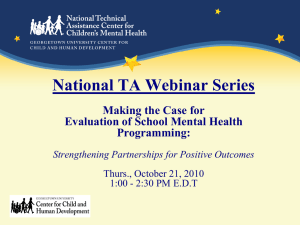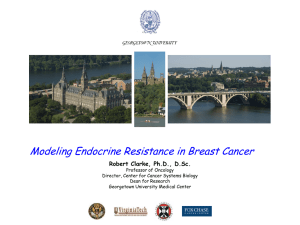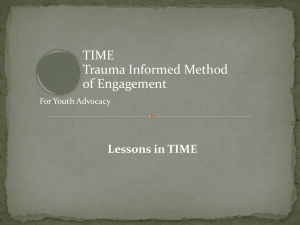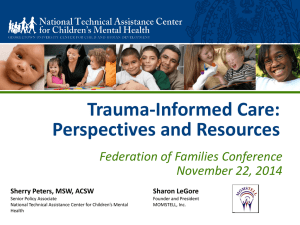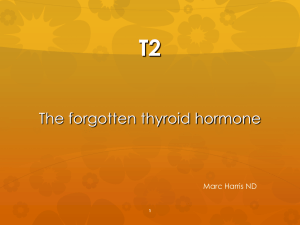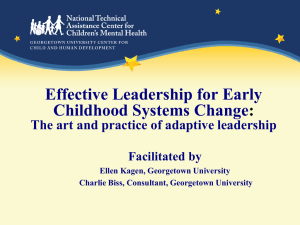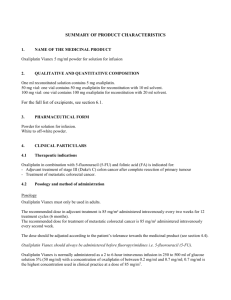ASCO_GI_2013_files/Pishvaian ABT
advertisement
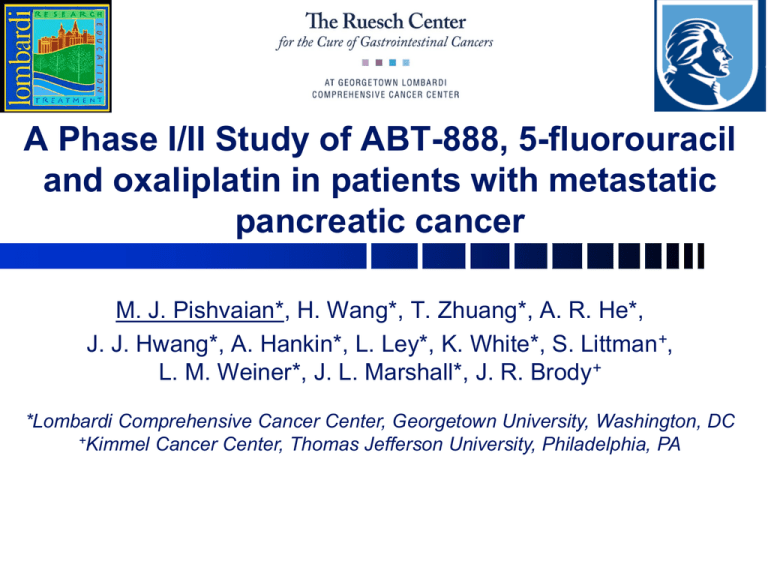
A Phase I/II Study of ABT-888, 5-fluorouracil and oxaliplatin in patients with metastatic pancreatic cancer M. J. Pishvaian*, H. Wang*, T. Zhuang*, A. R. He*, J. J. Hwang*, A. Hankin*, L. Ley*, K. White*, S. Littman+, L. M. Weiner*, J. L. Marshall*, J. R. Brody+ *Lombardi Comprehensive Cancer Center, Georgetown University, Washington, DC +Kimmel Cancer Center, Thomas Jefferson University, Philadelphia, PA Financial Disclosures • This clinical trial is funded by the Otto J. Ruesch Center for the Cure of GI Cancers, Lombardi Comprehensive Cancer Center • Abbott Inc. has provided research funding for a portion of the correlative science • I have no personal financial disclosures related to this work Pishvaian, et al Georgetown Lombardi Metastatic Pancreatic Cancer • Survival rates are poor • FOLFIRINOX • Gemcitabine + Abraxane • But OS still <1 year • Novel Targets • DNA damage control? Is there a therapeutic opportunity here? Pishvaian, et al Conroy, et al, NEJM, 2011 Von Hoff, JCO, 2011 Jones, et al, Science. 2008 Georgetown Lombardi Mechanisms of DNA Repair: PARP (Poly(ADP-ribose) polymerase) DNA DAMAGE PNK 1 XRCC1 pol β LigIII Chemotherapy Environmental factors (e.g. alkylating agents) (UV, radiation, chemicals) Normal physiology Radiotherapy (DNA replication, ROS) PARP • Critical DNA repair enzyme (SSB, BER) • Often overexpressed in cancer cells • Confers resistance to chemotherapy and radiation PARP Inhibition of PARP • Prevents recruitment of DNA repair enzymes • Leads to failure of single strand break repair Unrepaired break site replication fork arrest • Leads to degeneration into double-strand breaks • Ultimately chromosomal catastrophe cell death Cell Death Pishvaian, et al Tutt, A, et al, JCO /ASCO, 2009 Helleday T, et al. Nat Rev Cancer, 2008 Georgetown Lombardi • ABT-888 • • • Oral PARP-1, 2 inhibitor Proven PARP inhibition in vitro/in vivo Potentiates activity of multiple chemotherapies in pre-clinical models • Addition of the PARP inhibitor ABT-888 increased sensitivity to cisplatin Emty Vector PARP.R355D(Mut) PARP.E988A(Mut) PARP.W318R(Mut) 1.0 100 50 0.5 0.0 0 0 20 30 40 Cisplatin alone ABT-888+ Cisplatin 1.0 100 50 0.5 0.0 0 0 Pishvaian, et al 10 M Oxaliplatin % surviving cells • Exogenous mutant PARP increased sensitivity to oxaliplatin % surviving cells PARP Inhibition Increases Pancreatic Cancer Cell Sensitivity to Chemotherapy Brody, et al, unpublished data Donawho, CK, et al, Clin Cancer Res 2007 Palma, JP, et al, Clin Cancer Res 2009 Kummar, S, et al, JCO. 2009 2 4 6 M Cisplatin Georgetown Lombardi Homologous Recombination Deficient Cells Are More Susceptible to PARP Inhibition • Homologous recombination enzymes are critical for DNA repair • Defects in BRCA-1, -2, PALB-B2, FANC increased sensitivity to DNA-damaging chemotherapy and to PARP inhibition • BRCA-2 mutations in pancreatic cancer • 5 – 17% of pancreatic cancer patients carry BRCA-2 mutations • Multiple clinical trials of PARP inhibitors • • Pishvaian, et al Consistent evidence of increased efficacy in BRCA-1 or -2 mutant tumors Anecdotal evidence in pancreatic cancer • e.g. Lowery, et al, 2011, MSKCC - 15 patients with known BRCA-1 or -2 mutations • 4 patients with PARPi-based therapy • 3PRs and one SD for 6 months Rowe and Glazer Breast Cancer Research ,2010 Goggins, M, Cancer Res 1996 Murphy KM, Cancer Res 2002 Ozçelik, H, Nat Genet 1997 Lowery, et al, Oncologist, 2011 Georgetown Lombardi Phase I/II Trial of 5FU, Oxaliplatin, and ABT-888 in Pancreatic Cancer • Phase I – ABT-888 dose escalation • Mixture of untreated and previously treated patients • Phase II - two strata • Untreated vs. previously treated Oxaliplatin 85mg/m2 Leucovorin 400mg/m2 5-FU Bolus 400mg/m2 5-FU CI 2400mg/m2 ABT-888 Orally BID Oxaliplatin 85mg/m2 Leucovorin 400mg/m2 5-FU Bolus 400mg/m2 5-FU CI 2400mg/m2 ABT-888 Orally BID Day 1 2 3 4 5 6 7 Cycle 1 Pishvaian, et al 15 Oxaliplatin 85mg/m2 Leucovorin 400mg/m2 5-FU Bolus 400mg/m2 5-FU CI 2400mg/m2 ABT-888 Orally BID 29 Cycle 2 Oxaliplatin 85mg/m2 Leucovorin 400mg/m2 5-FU Bolus 400mg/m2 5-FU CI 2400mg/m2 ABT-888 Orally BID Response Assessment 43 Cycle 3 56 Cycle 4 Georgetown Lombardi Inclusion/Exclusion Criteria • Inclusion Criteria • • • • • • Metastatic pancreatic adenocarcinoma Measurable or evaluable disease Adequate hepatic, bone marrow, and renal function Age ≥ 18 years ECOG performance status 0-2 Exclusion Criteria • Untreated CNS metastases • Active severe infection • Active cardiovascular disease • Women who were pregnant or breastfeeding • Anticipated patient survival under 3 months Pishvaian, et al Georgetown Lombardi Trial Design – Phase I • Primary objective • Recommended phase II dose • Secondary objectives • • • • Response rate Progression free survival Overall Survival Pharmacokinetics • Study design • Standard 3+3 dose escalation Pishvaian, et al Cohort -1 1 2 3 4 5 6 7 8 ABT-888 (mg) 20 40 60 80 100 150 200 250 300 Georgetown Lombardi Results - Patients • 01/2011 to 01/2013, 28 patients enrolled • 62% untreated • Median Age – 64 years • Range 45 to 79 • 19 Male, 9 Female • Median ECOG PS – 1 • 0 - n=7 • 1 - n=20 • 2 - n=1 • Previously treated • Cohort -1 1 2 3 4 5 ABT-888 (mg) 20 40 60 80 100 150 6 7 8 200 250 300 N 6* 3 3 3 3 DLT 4# 6* Replaced DLT Median number of prior chemotherapy regimens - 1.5 (Range 1-3) Pishvaian, et al Georgetown Lombardi Adverse Events in ≥ 10% Grade CTCAE_Term Nausea Vomiting Fatigue Dysesthesia Paresthesia Neutropenia Thrombocytopenia Pain Diarrhea Lymphopenia Constipation Anorexia Anemia Cognitive disturbance Gastroparesis Total Pishvaian, et al 1 11 9 6 8 7 1 4 3 3 1 3 4 2 2 2 66 2 3 1 4 0 0 4 2 1 1 2 1 0 0 1 1 21 3 0 0 0 0 0 1 0 2 1 1 0 0 1 0 0 6 5 0 0 0 0 0 1 0 0 0 0 0 0 0 0 0 1 total 14 10 10 8 7 7 6 6 5 4 4 4 3 3 3 94 Georgetown Lombardi Adverse Events, ≥ Grade 3 Grade CTCAE_Term Neutropenia Pain Diarrhea Lymphopenia Anemia Total 3 1 2 1 1 1 6 5 1 0 0 0 0 1 total 7 6 5 4 3 25 • Primary toxicity has been myelosuppression • Prolonged more than severe Pishvaian, et al Georgetown Lombardi Adverse Events – Trial Modification • Patients 1 – 6 • Dose delayed for myelosuppression in 3 of 6 patients • June, 2011 – 5FU bolus dropped • Patients 7 – 22 • Dose delayed for myelosuppression in 1 of 16 patients • Patients 23 – 26 @ ABT-888, 250mg BID • Dose delayed for myelosuppression in 3 of 4 patients Pishvaian, et al Georgetown Lombardi Efficacy Outcome • As of 01-14-2013 - Analysis of 18 evaluable patients • • Untreated (n = 11) Previously Treated (n= 7) Untreated mOS = 7.4 months ORR = 18% (2 cPR) Previously Treated mOS = 5.4 months ORR = 14% (1 cPR) OS Pishvaian, et al Untreated mPFS = 3.9 months Previously Treated mPFS = 1.8 months PFS Georgetown Lombardi Patient Numbers Preliminary Results BRCA-2 mutation 66 11 11 15 15 33 17 17 55 10 10 Overall Survival Progression-Free Survival Months – Untreated 0 Patient Numbers 0.00 14 13 4 7 15 12 2 9 2 2.00 4 4.00 6 6.00 8 8.00 10 10.00 12 14 12.00 14.00 16.00 16 18.00 18 20 20.00 BRCA-2 mutation 14 13 4 7 Overall Survival Progression-Free Survival 16 12 Months – Previously Treated 2 9 0.00 0 2.00 2 4.00 4 6.00 6 8.00 8 10.00 10 12.00 12 14.00 14 • 2 patients with defined BRCA2 mutations Pishvaian, et al Georgetown Lombardi Conclusions • 5FU, Oxaliplatin, and ABT-888 has been safe to administer • Toxicities parallel those with FOLFOX alone • RP2D likely 200 or 250mg of ABT-888 BID • There is evidence of anti-cancer activity: • 3 PRs and 10 with Stable Disease • Particular benefit in BRCA-2 mutation carriers • Correlative studies for predictive subgroups are pending • Good tissue acquisition rate Pishvaian, et al Georgetown Lombardi PARP Inhibitor-Based Therapy in Pancreatic Cancer • • • • • • • NCT01585805 – Gem/Cis + ABT-888 • Eileen O’Reilly, MSKCC NCT01233505 – CAPOX + ABT-888 • William Schelman, University of Wisconsin NCT01366144 – Carbo/Taxol + ABT-888 hepatorenal dysfunction • Hussein Tawbi, University of Pittsburgh NCT01281150 – Carbo/Taxol + ABT-888 • Chandra P. Belani, Penn State NCT00892736 – ABT-888 Single agent • Edward Chu, U. Penn NCT01154426 – Gemcitabine + ABT-888 • Ronald Stoller, University of Pittsburgh NCT00576654 – Irinotecan + ABT-888 • Patricia LoRusso, Karmanos Cancer Institute Pishvaian, et al • • • • • NCT01296763 – Irinotecan, Cisplatin, Mitomycin C + Olaparib • Michael Goggins, Johns Hopkins NCT01286987 – BMN 673 single agent • Andrew Dorr, BioMarin Pharmaceutical NCT01482715 – Rucaparib single agent • Clovis Oncology, Inc. NCT01009190 - PF-01367338 + various chemotherapies • Clovis Oncology, Inc. NCT01618136 - E7449 + temozolomide OR carbo/taxol • Eisai, Inc Georgetown Lombardi Acknowledgments • Otto J. Ruesch Center for the Cure of GI Cancer • The patients and their families • Biostatisticians • • • Tingting Zhuang, MS Hongkun Wang, PhD Clinical Care and CRMO • • • • • • • John Marshall, MD Louis M. Weiner, MD Jimmy Hwang, MD A. Ruth He, MD, PhD Amy Hankin, PA Lisa Ley, RN Keisha White, RN • Thomas Jefferson • Jonathan Brody, PhD • Susan Littman, MD • Patient #14 • Ben Tan, M.D., Wash U. • Robert Wolff, M.D., MDACC • Indivumed • Nina Gabelia, MD, MPH • Lana Kapanadze, MS • HTSR - Lombardi • Deborah Berry, PhD • Abbott • Meeta Jaiswal, PhD Pishvaian, et al Georgetown Lombardi


